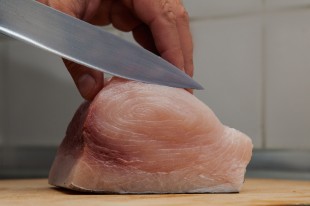Fish and mercuryPesce e mercurio

those of large size may have high amounts of metal harmful to pregnant women. What to do? The advice of EFSA
The number of seizures of large fish tagliacome swordfish, tuna, sharks, porbeagle due to excessive presence of methylmercury increases continuously, especially in Italy. In the first 5 months of this year have been confiscated 40 lots, and the numbers have doubled over the previous year. The Food Done had already dealt with this problem, focusing on how these warnings food. The particular problem for consumption by children, the elderly and pregnant women. The fish is in fact a valuable source of nutritious food for our body and helpful in omega 3, and this is why it is considered essential in a balanced diet. The fish, however, is a typical example of food “double-edged sword” because it is an excellent source of omega-3 fatty acids and other nutrients, such as iodine, essential for intrauterine development and in particular the nervous system. At the same time it is an accumulator of environmental contaminants, first of methylmercury, but not only, to be harmful to the development of the nervous system.
The fish that arrives on our plates is controlled by veterinarians of the National Health Service and health requirements must be in compliance with the European standards, considered to be very strict and constantly updated by EFSA. However, it is reasonable to ask if a woman is expecting a baby eating more fish in order to increase the amount of omega 3 does not come to pass the “threshold” tolerated by the body for the recruitment of other contaminants. Methylmercury and other pollutants, in contrast to pesticides or additives, are in the environment and their presence (even if in traces) in the catch is hardly avoidable. At this point the question arises whether eating fish can often lead to a dangerous organism bioaccumulation of these chemicals present in the “tracks.”
The problem is especially large fish such as tuna, swordfish and porbeagle
The problem has been studied in undocumento Institute of Health in 2012. Opinion on the fish in 2005, EFSA concludes that the content of nutrients and contaminants is not substantially different between the fish and the fish raised: while the first bioaccumulate pollutants through the environment, bioaccumulate through the second conventional feed, composed of small marine organisms. One solution would be to use on farms feed based on herbal ingredients: This is an interesting path to reduce the bioaccumulation of contaminants while preserving the nutritional value, although today it is not widely used.
The other issue relates to the size of the fish. The large predators (tuna, swordfish, emery …) tend to accumulate more methylmercury, while fatty fish such as herring, tend to accumulate more readily soluble contaminants (such as dioxins and polychlorinated biphenyls). The salmon has the characteristics of both categories “at risk”, being medium in size and having a high amount of fat. On the other hand it should be pointed claws species classified as “fat” are an excellent source of omega 3.
The fish is an essential food for the intake of omega-3 and other nutrients useful for pregnant women
“A recent evaluation by EFSA in 2014 – said Alberto Mantovani toxicologist Institute of Health – focuses attention on the omega3 and methylmercury, fish being the most important source in the human diet. The paper believes that a fish consumption equal to 3-4 servings per week during pregnancy may have beneficial effects on embryo-fetal development of the nervous system and is definitely recommended to consume it. The same goes for consumption up to 2 servings per week in the general population, given the beneficial effects of omega-3 intake on the cardiovascular system. With regard to methylmercury – continues Mantovani-considering the amount in fish consumed in Europe, 3-4 servings per week does not pose a risk, although these should not exceed this average level of intake. According to the EFSA higher consumption does not bring more benefits. It is worth adding that it is always advisable to vary the type, taking advantage of the variety present in fish, and maybe focusing on the species of fish called poor. “
quelli di grossa taglia possono avere elevate quantità di metallo dannoso per le donne in gravidanza. Cosa fare? I consigli dell’Efsa
La quantità di sequestri di pesce di grossa tagliacome pesce spada, tonno, squali, smeriglio a causa di un’eccessiva presenza di metilmercurio aumenta continuamente soprattutto in Italia. Nei primi 5 mesi di quest’anno sono stati confiscati 40 lotti, e i numeri sono raddoppiati rispetto all’anno precedente. Il Fatto Alimentare si era già occupato di questo problema,focalizzando l’attenzione sulle modalità di queste allerta alimentari. Il problema riguarda in particolare il consumo da parte di bambini, anziani e donne in gravidanza. Il pesce infatti è una fonte preziosa di alimenti nutritivi utili per il nostro organismo e di omega 3 ,ed è per questo che viene considerato indispensabile all’interno di una dieta equilibrata. Il pesce però è il tipico esempio di alimento “a doppio taglio”, perché è un’eccellente fonte di acidi grassi omega-3 e di altri nutrienti, come lo iodio, essenziali per lo sviluppo intrauterino e in particolare del sistema nervoso. Nello stesso tempo è un accumulatore di contaminanti ambientali, in primo luogo di metilmercurio, ma non solo, ritenuti dannosi per lo sviluppo del sistema nervoso.
Il pesce che arriva sulle nostre tavole è controllato dai veterinari del Servizio Sanitario Nazionale e deve avere requisiti sanitari in regola con le normative europee, considerate molto severe e continuamente aggiornate dall’Efsa. Tuttavia è ragionevole chiedersi se una donna che aspetta un bambino mangiando più pesce in modo da incrementare la quantità di omega 3 non arrivi a superare la “soglia” tollerata dall’organismo per l’assunzione dei altri contaminanti. Il metilmercurio e altri inquinanti, al contrario di pesticidi o additivi, sono nell’ambiente e la loro presenza (anche se in tracce) nel pescato è difficilmente evitabile. A questo punto si pone la domanda se mangiare spesso pesce può portare ad un pericoloso bioaccumulo nell’organismo di questi composti chimici presenti in “tracce”.
Il problema è stato esaminato in undocumento dell’Istituto Superiore di Sanità del 2012. Nel parere sul pesce del 2005, l’EFSA conclude dicendo che il contenuto di nutrienti e di contaminanti non è sostanzialmente diverso fra il pesce pescato e quello allevato: mentre il primo bioaccumula gli inquinanti attraverso l’ambiente, il secondo bioaccumula attraverso i mangimi convenzionali, composti da piccoli organismi marini. Una soluzione potrebbe essere quella di utilizzare negli allevamenti mangimi basati su ingredienti vegetali: si tratta di un percorso interessante per ridurre il bioaccumulo di contaminanti mantenendo intatto il valore nutrizionale, anche se ad oggi è poco utilizzato.
L’altra questione riguarda le dimensioni del pescato. I grossi predatori (tonno, pesce spada, smeriglio…) tendono ad accumulare più metilmercurio, mentre i pesci grassi come l’aringa, tendono ad accumulare più facilmente contaminanti liposolubili (come diossine e policlorobifenili). Il salmone presenta le caratteristiche di ambedue le categorie “a rischio”, essendo di medie dimensioni ed avendo una quantità elevata di grasso. Per contro va ricordato chele specie classificate come “grasse” sono un’eccellente fonte di omega 3.
«Una recentissima valutazione dell’EFSA del 2014– spiega Alberto Mantovani tossicologo dell’Istituto superiore di sanità – concentra l’attenzione sugli omega3 e sul metilmercurio, essendo il pesce la fonte più importante nella dieta dell’uomo. Il documento ritiene che un consumo di pesce pari a 3-4 porzioni alla settimana durante la gravidanza, possa avere effetti benefici sullo sviluppo del sistema nervoso embriofetale ed è sicuramente raccomandabile consumarlo. Lo stesso discorso vale per un consumo sino a 2 porzioni la settimana nella popolazione generale, dati i benefici effetti dell’assunzione di omega-3 sul sistema cardiovascolare. Per quanto riguarda il metilmercurio – prosegue Mantovani- considerando le quantità nel pesce consumato in Europa, le 3-4 porzioni a settimana non rappresentano un rischio, anche se tuttavia è opportuno non superare questo livello di assunzione medio. Secondo l’Efsa un consumo più alto non apporta maggiori benefici. Vale la pena aggiungere che è sempre opportuno variare la tipologia, approfittando della varietà presente in pescheria, e magari focalizzando l’attenzione sulle specie di pesce cosiddette povere».

